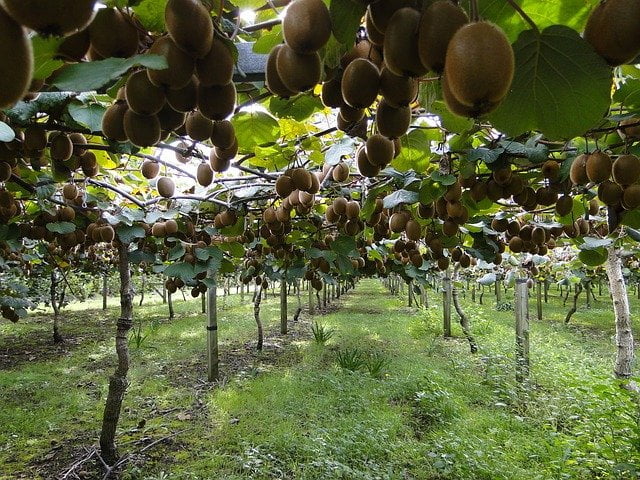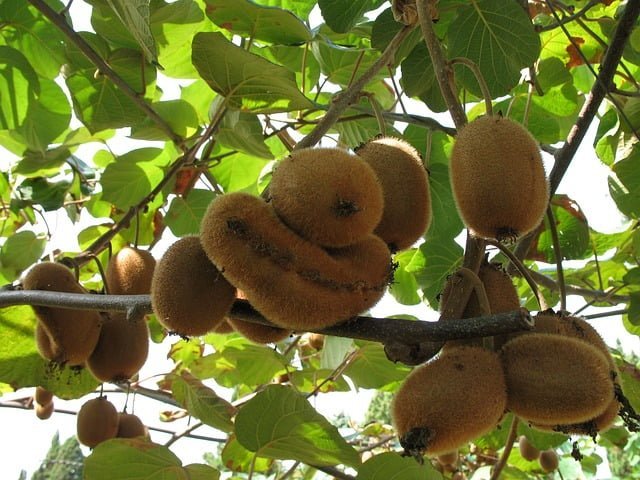This ultimate guide on kiwi farming will help you to cultivate kiwi in your farm. Get to know best kiwi farming practices by experts. To start cultivation of kiwi a farmer needs precise knowledge.
Growing Kiwi is profitable if you follow good farm practices. Kiwi fruits have a huge demand in the market. The market value is increasing at the rate of 4.1% annually. According to the resources, in the year 2019, sales value of kiwi touched $6.9 Billions globally.
Just like lavender farming, cultivating kiwi whether in small or large farms can create a good amount of profit.
But, growing them without scientific and researched knowledge can cause losses. That’s why I am writing this article for you. So that you follow good farm practices and earn profit from your farm enterprise.
Table of Contents
Introduction
Kiwi is a deciduous vine fruit crop that is also popular as “Chinese Gooseberry.” They are wonderful source of Vitamin B and C. Moreover kiwi fruits are also packed with minerals such as potassium, phosphorus, and calcium.
People not only consume kiwi as a fruit but it is also used in industries to prepare wine and squash. Moreover, from a single mature vine of kiwi you can get 80 to 90 Kilograms of Kiwi fruits.
So imagine how much you can sell from an acre of land. Whether you are a small scale or large scale farmer, practicing kiwi farming can help in making profits.
Botanical Classification
Botanical Name: Actinidia deliciosa or A. chinensis
Family: Actinidiaceae
Order: Ericales
Class: Magnoliopsida
Division: Magnoliophyta
Chromosome Number: 29
Source: www.ncbi.nlm.nih.gov
Origin Of Kiwi Fruit
According to zespri.com, Kiwi fruit originated in China. “Yang Tao” was the popular name of kiwifruit in China. However, during 20th century, Isabel Fraser, a school principal brought kiwi seeds from China to New Zealand.
Cultivation and development of the kiwi cultivars started on the large scale in New Zealand.
Area & Production
According to atlasbig.com, globally 4 million tons of kiwi was produced in the year 2018. However, China is the leading producer of Kiwi with production of around 2.2 million tons. China produces slightly more than half of the world’s total kiwi production.
This is followed by Italy, New Zealand, Iran, Chile, Greece, France, Turkey, etc.
Kiwi Farming Guide
For successful cultivation of kiwi, you need to know best scientific method to cultivate Kiwi. Moreover, get to know soil and climate requirements to grow kiwi vines.
Soil Requirement
For cultivation of kiwi, deep, rich, and well drained sandy loam soil is ideal. However, soil pH should be between 6.5 to 7.3. Soil pH more than 7.3 can result in lesser yield.
This is because, Magnesium is deficit in soil having pH more than 7.3.
Climate & Temperature
Kiwi fruit vine is a temperate season crop. Hence it can not tolerate hot tropical climate. You can grow kiwi in plant hardiness zones 5, 6, 7, 8, and 9. Kiwi plant can not withstand frost but 800 chilling hours is required to cultivate kiwi.
This means that during winters at least for 700 to 800 hours, average temperature should remain below 7 degrees Celsius. Hilly regions that are 800 to 1500 metres above mean sea level are considered ideal for cultivation of kiwi.
During summers temperature should not rise above 35 degrees Celsius. Above this temperature range, scorching of leaves can occur.
Field Preparation
You can prepare land for kiwi farming by converting steep land into terraces. Direction of rows should be in north south direction. This will ensure utilization of maximum sunlight required for the growth of vines.
Prepare land during December by making pits. Maintain 4 metres spacing between row to row and 5 metres to 6 metres from plant to plant. Add Farm Yard Manure(FYM) or any well decomposed bulky organic manure in the month of December in pits.
Pit depth should be at the same depth at which kiwi vines were growing in the nursery.
You can also add Jeevamrut or Sanjeevak after application of FYM. This will help to increase fertility of the soil. Take special of drainage in the field. As waterlogging condition can affect the growth of kiwi vines.

Planting Material & Season
You can easily propagate kiwi vine from seeds or vegetative propagation. Propagating kiwi vines from cutting or grafting is considered best for farming practices. This is because they are identical to the mother plant.
And difference between male and female flower bearing plant remains clear. Plant 5 female plants for one male plant. This will help in promoting pollination that will result in higher fruit yield.
The best season for kiwi plantation is during spring season. You can start plantation from late January to March. For plantation adopt T-bar or Pergola system.
At the time of plantation prune kiwi plant to 30 centimetres. This will help in promoting vigorous growth in kiwi plant.
Variety
Select variety that are suitable for growing in your region. You can contact the nearest Agriculture Department to know about best kiwi varieties. However, Abbott, Allison, Bruno, Hayward, and Monty are the famous varieties of Kiwi.
Irrigation
Annual rainfall of 150 centimetres/year is sufficient to cultivate kiwi. During summer season, irrigate daily or at a gap of two days. for first five years after plantation. However both excessive irrigation and poor drainage can kill your crop.
But under irrigation can result in reduced or stunted plant growth. You can also use drip, or mini sprinkler, or impact sprinkler for irrigation purpose. This will help in reducing water loss and will result in higher water use efficiency.
Reduce irrigation during September to October. During this time irrigate at an interval of 10 to 15 days. Heavy irrigation during this time can lead to frost damage in plants during winters.
Fertilizers
You can apply fertilizers twice in a year. Give first application during March to April. However, avoid adding fertilizers too close to plant roots. One full bearing vine requires 500 grams of Nitrogen in a year.
Apply 50 to 60% of the total required nitrogen fertilizer during March. And the rest quantity can be applied at once or in two split dozes before August. Along with this you should also apply 600 grams Phosphorus and 800 grams Potassium.
Apply 20 Kilograms of Farm Yard Manure or any bulky organic manure every year as basal doze.

Training & Pruning
Training is very important for successful farming of kiwi. Training helps in maintaining a well formed framework of branches. It is necessary to train even before planting of vines or as early after plantation.
You need to erect the growth of supporting vines as well. For this purpose construct three types of supporting structures.
Construct 2 metres high pillars made up of wood, concrete or iron. Place them near the growing vines. Fix one 2.5 mm thick tensile wire on the top of the pillars. A cross arm on the pole will carry two outriggered wires.
This training system is known as T bar training system.
Avoid curling of main vines around the pillars. Prune out all lateral branches till the top of the pillar. Pruning top portion of the vine at the end of pillar will help in promoting lateral growth. Hence lateral branches will develop along the wires in the framework.
Winter is the best season for pruning of kiwi vines.
Pests & Diseases
No serious pests and diseases affects kiwi crop so far. That’s why it is very profitable to grow. However, excess watering or waterlogging condition can lead to fungal diseases.
Phytopthora a soil fungus can lead to the development of root rot. To avoid any chances of fungal disease avoid over irrigating and maintain good drainage facility. Keep removing any weed time to time.
Harvesting
4 to 5 years after plantation, kiwi vines will start bearing fruits. Due to the variation in temperature and variety the fruit can mature at different times.
Generally they mature earlier in lower altitude and later in higher altitude. Harvest the large sized well developed fruits and leave smaller ones to develop further. From a single vine of kiwi fruit you can harvest around 50 to 100 Kilograms of Kiwi.
FAQ
Can I do cultivation of kiwi in Bhagalpur?
No, climate of Bhagalpur, Bihar is not suitable for cultivating kiwi. At least 800 chilling hours is required during winters and temperatures during summers should not rise above 35o Celsius.
How many doses to give waste decomposer or micronutrient to kiwi fruit tree?
You can apply waste decomposer once after every 15 days during active growing season of kiwi fruit tree.
Kiwi fruit ripening season in India?
In India, kiwi fruit ripens between October to December.
What is the role of weather in kiwi fruit?
Weather and climate plays crucial role in kiwi fruit. It determines vine development, fruiting, breaking of dormancy, etc.
What are the environmental impacts of transporting kiwi fruit?
Due to evaporation during transportation weight of kiwi fruits get reduced. To prevent this loss, they are wrapped in perforated film and packed in single layers in wooden, or plastic trays with plastic inserts.





Last 5 year I grow kewi plant in my garden but one male or female plant dry
Hi Mohammad Shafi Banday,
Sorry to hear about your loss. But poor health of a plant can be because of various reasons like disease or pest attack, climatic conditions, soil type, etc. However Kiwi plant has specific requirements to grow and fruit properly. Do check out this guide to grow kiwi in your garden – How to grow kiwi.
I hope this will help!
Very nice Informstion.
Please see update in Hindi language.
9650003042
Hi Mahesh Garia,
You can read kiwi farming guide in hindi here – Kiwi Cultivation Hindi
Please provide information regarding kiwi production in view growing in Dist Bageshwar UTTRAKHAND
Hi Mahesh Garia,
You can follow this guide to cultivate kiwi in Bageshwar, Uttarakhand. Hilly regions of Uttarakhand are fit for kiwi farming. If you have any specific query then you can also connect with Agriculture Review on Facebook and Instagram.
I hope this will help!
Can we grow kiwi in west UP
Hi Dharmendra,
Yes you can grow kiwi in hilly regions of Western Uttar Pradesh. Do read soil, climate and temperature requirements for kiwi farming in this guide. It will help you to check whether your farm can fulfil the specific requirements for kiwi cultivation or not. I hope if it matches with the requirements then one day you will be a successful kiwi farmer.
For further help and queries you can connect with me on Facebook and Instagram too. I hope this will help!
Hello Mr.Aditya
That was a really a useful information, can u suggest whether nilgiris district in Tamil Nadu will really suit for kiwi.
Regards,
Prabhakar Mayavelu
Hi Mr. Prabhakar,
Yes, according to the reports of Ministry of Agriculture, you can cultivate kiwi in Nilgiri District in Tamil Nadu.
Can we grow kiwi ph soil 6.0-7.5 karnataka Ap border
Yes, you can cultivate kiwi.